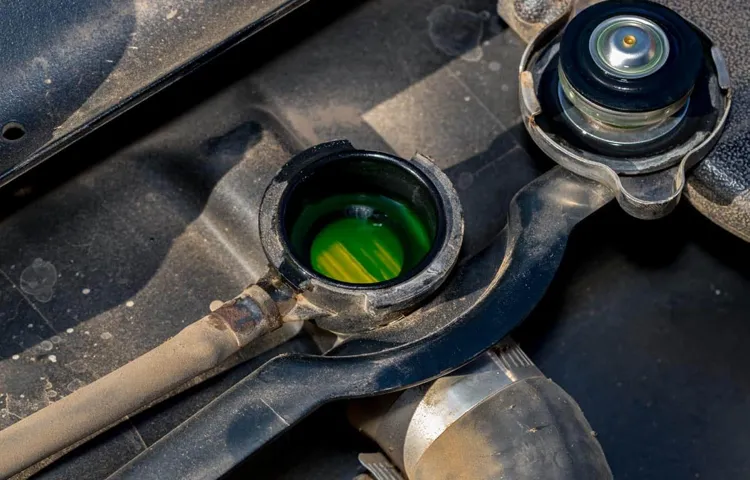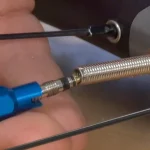Have you ever wondered where coolant in your car actually goes? It’s not uncommon to see the “low coolant level” warning light pop up on your dashboard, but understanding where the coolant is going can help prevent potential problems down the road. Coolant is a crucial component of your car’s cooling system, which helps regulate the engine’s temperature to prevent overheating. When the engine is running, the coolant circulates through the engine, radiator, and heater core, absorbing heat and transferring it away from the engine.
But over time, coolant can escape through leaks, evaporation, or simply being consumed by the engine. Knowing where coolant is likely to leak from can help prevent problems before they start. Common leak points include hoses, the thermostat housing, water pump, and radiator.
If you notice a drop in coolant level, be sure to have your car inspected by a mechanic to identify the source of the leak and prevent potential engine damage. So, the next time you see the low coolant warning light come on, think of it like a game of hide and seek—your coolant could be hiding in a variety of places, and it’s up to you to find out where!
Table of Contents
Introduction
Have you ever wondered where the coolant in your car goes? A car’s cooling system is designed to regulate the temperature of the engine and prevent it from overheating. The coolant, typically a mixture of water and antifreeze, is circulated through the engine by a pump and absorbs the heat generated by the combustion process. It then flows through the radiator where it is cooled by air before returning to the engine to repeat the cycle.
During normal operation, the coolant level should remain relatively constant, but if there is a leak, the coolant can escape and potentially cause damage to the engine. It’s important to regularly check the coolant level and address any leaks promptly to prevent costly repairs down the road. So, the next time you’re wondering where all that coolant goes, remember it’s simply circulating through your car’s cooling system to keep your engine running smoothly.
Explaining coolant
Coolant is an important part of a vehicle’s engine system, but many people may not fully understand what it is or how it works. Essentially, coolant is a liquid that helps regulate the temperature of the engine by absorbing heat and carrying it away from the engine. It’s typically a mixture of water and antifreeze, which helps prevent the engine from freezing in cold temperatures and from overheating in hot temperatures.
The coolant flows through the engine and is circulated by the water pump, ultimately passing through the radiator where the heat is dissipated into the air. It’s important to regularly check the coolant level and ensure that it’s clean and free from debris to prevent damage to the engine. Overall, coolant plays a crucial role in keeping the engine operating at a safe temperature and ensuring optimal performance.

Importance of coolant
Coolant is an essential fluid in the smooth functioning of an engine, but its importance is often underestimated. It works as a temperature regulator, keeping the engine from overheating during extended operations. Without the right amount of coolant, your engine is at risk of breaking down due to heat damage.
A lack of coolant can cause parts of your engine to warp or even crack. Therefore, it’s necessary to keep the coolant reservoir filled and check the level regularly. Adequate coolant levels are critical to the longevity of an engine.
So, whenever you’re performing routine maintenance, make sure to check the coolant level and top it off as necessary. Trust us; your engine will thank you.
Where coolant goes
Coolant is a vital fluid in any vehicle’s engine that helps to regulate its temperature. But where does it go? Well, coolant circulates through the engine block, radiator, heater core, and water pump, so it’s difficult to pinpoint exactly where it goes. In a properly functioning engine, coolant stays contained within the system.
However, if there’s a leak, it can escape through various components such as the hoses, cracked radiator, or a faulty water pump. If you notice a decrease in coolant levels or the engine is overheating, it’s important to inspect the cooling system and locate the source of the leak. Neglecting to address coolant loss can lead to costly engine damage down the road.
So, keep an eye on your coolant levels, and if in doubt, take your vehicle to a trusted mechanic for inspection and any necessary repairs.
Coolant circulation in engines
Coolant circulation is a crucial part of any engine’s functioning. When the engine warms up, the coolant starts flowing through the engine block, through the radiator, and back again, keeping the engine’s temperature within optimal levels. This circulation process is highly important, as any engine that overheats can become damaged beyond repair.
The coolant takes away excess heat from the engine by absorbing it and dissipating it through the radiator. It’s sort of like how fans work: they absorb heat and then blow it back out into the atmosphere to cool the area. Without successful circulation, the coolant cannot do its job and the car engine risks experiencing a complete failure, which can be a costly repair.
Therefore, it’s important for drivers to ensure that their engine’s coolant circulation is running smoothly by having regular maintenance checks.
Coolant in car heaters and radiators
Coolant is an essential part of any car’s heating and cooling system. It is typically a mixture of water and antifreeze, and its main purpose is to regulate the operating temperature of the engine. But have you ever wondered where the coolant goes? In most modern cars, the coolant circulates through the engine block, where it absorbs heat from the combustion process, and then flows through the radiator to release that heat into the air.
The coolant also runs through the car’s heater core, which provides heat for the cabin. To ensure that the coolant is always at the right level, there is a coolant reservoir located near the radiator. If you notice that your car’s heater is not working, or that the engine is overheating, it may be a sign that the coolant level is low, and it’s time to top it up.
Regular coolant maintenance is crucial to keep your car’s engine running smoothly and to avoid any costly repairs down the road.
How to check coolant levels
Checking your coolant levels is an essential part of routine vehicle maintenance, and it’s something that every driver should know how to do. Coolant, also known as antifreeze, is a vital component of your vehicle’s cooling system. It helps regulate engine temperature and prevents your car from overheating.
If you don’t have enough coolant, your engine can overheat, which can lead to significant damage and costly repairs. So, where does the coolant go? Coolant is stored in the radiator, and as your engine heats up, the coolant expands and flows into the engine block and back into the radiator. It’s essential to check your coolant levels regularly and ensure that your coolant is topped off to prevent any potential damage to your engine.
To check your coolant levels, locate the coolant reservoir tank, which is typically clear and located near the radiator. Check the levels against the markings on the side, and if they’re low, add more coolant until they reach the appropriate level.
Proper handling of coolant
When it comes to using coolant in your vehicle, it’s important to handle it properly to ensure it doesn’t harm the environment. Coolant, also known as antifreeze, is typically a bright green or orange liquid that is used to regulate the temperature of your engine by absorbing heat and carrying it away to the radiator. However, it is toxic to animals and can contaminate water sources if not properly disposed of.
So where does your coolant go once it’s done its job? It’s important to always dispose of used coolant at a designated facility that can properly handle it. This could be a service station or a recycling location. Never dispose of it by pouring it down the drain or into the soil, as this can harm the environment and put animals at risk.
By properly handling your coolant, you can help protect the world around you while still maintaining the life of your engine.
Safe practices when handling
Proper handling of coolant is essential to ensure safety in the workplace. Coolant can be hazardous if not handled correctly, as it may contain various chemicals that can harm people or the environment. To prevent these dangers, you must use protective equipment such as gloves, goggles, and masks when handling coolant.
Additionally, you should ensure that the coolant is stored in a labeled, non-corrosive container, and kept in a well-ventilated area. You should also avoid direct skin contact with the coolant and never dispose of it in the sink or drains. Properly disposing of coolant is important, as it can contaminate water sources and cause harm to aquatic life.
By following these safe practices, you can prevent injury and pollution and ensure a safer environment for yourself and those around you.
Disposal of coolant
Coolant is an essential component for keeping engines cool, but it can also be a hazardous material if not handled properly. Disposal of coolant must be done carefully, as it contains chemicals that can harm the environment. The best way to dispose of coolant is to take it to a licensed waste management facility.
Pouring coolant down the drain or on the ground is illegal and can result in hefty fines or legal action. It’s also important to remember not to mix different types of coolant, as this can result in hazardous chemical reactions. Always store coolant in a secure container away from children and pets.
By handling and disposing of coolant with care, you can help keep both the environment and people safe from harm.
Conclusion
In the never-ending cycle of car maintenance, coolant is but a fleeting visitor. Like a nomad of the automotive world, it travels through the engine, keeping things cool and collected, before eventually making its way out and onto the open road. Whether it’s recycled, evaporated, or simply lost to the wind, one thing is certain: coolant always ends up where it needs to be.
And while its journey may be short-lived, its impact on the longevity and performance of our vehicles is nothing short of essential. So next time you’re wondering where your coolant went, just know that it’s out there, doing its job and keeping your engine running smoothly. In the end, that’s all that really matters.
“
FAQs
What is coolant and its importance in a car’s engine?
Coolant is a mixture of water and antifreeze that helps regulate the temperature inside the car’s engine. It helps prevent overheating and protects against corrosion and freezing.
How often should you check your car’s coolant level?
You should check your car’s coolant level at least once a month or before embarking on a long journey to ensure it’s at the recommended level.
Can you mix different types of coolant in your car’s engine?
Generally, it’s not recommended to mix different types of coolant in your car’s engine. It’s best to use the same type of coolant recommended by the manufacturer.
What are the signs that your car’s coolant needs to be changed?
Signs that your car’s coolant needs changing may include a sweet smell from the engine, visible coolant leaks, and overheating of the engine.
How do you properly dispose of old coolant?
Old coolant should be disposed of at a hazardous waste disposal site. Do not pour it down the drain or into the environment, as it can be harmful.
Can low coolant levels affect your car’s performance?
Yes, low coolant levels can cause your car’s engine to overheat, which can lead to decreased performance and potential damage to the engine.
Where does the coolant go in your car’s engine?
The coolant flows through the engine and into the radiator, where it is cooled before circulating back through the engine. This cycle helps regulate the engine’s temperature.


